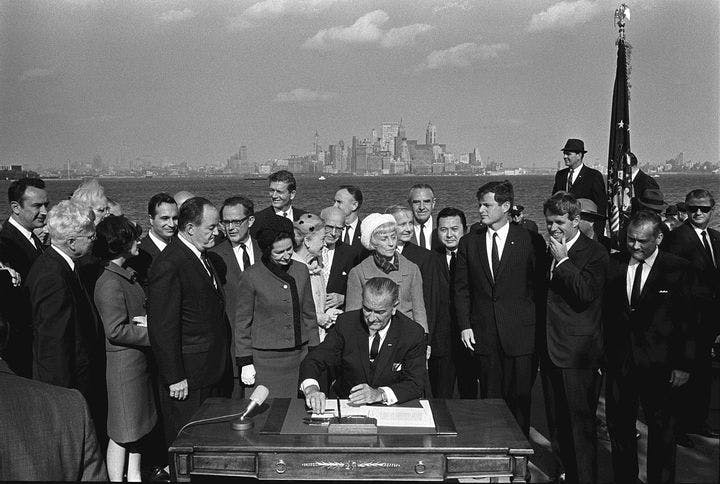Summer 2012
Did the 1965 Immigration Act backfire?
– The Wilson Quarterly
How immigration quotas and harsh enforcement backfired.
In April, the Pew Research Center reported that the net number of people migrating from Mexico to the United States had fallen to zero, and might even have entered negative territory, largely thanks to the evaporation of job prospects in the United States. This finding coincides with the end of a four-decade trend that saw the Hispanic population of the United States rise from 10 million in 1970 to 50 million in 2010. What caused the upsurge? An ill-conceived immigration reform law in 1965 and decades of harsh enforcement policies that backfired, contend Princeton sociologist Douglas S. Massey and Karen A. Pren, manager of Princeton’s Mexican Migration Project.
The Immigration and Nationality Act of 1965 was intended to open a new era for U.S. immigration policy. The sweeping legislation did away with retrograde quotas on select nationalities, replacing them with quotas that prioritized immigrants’ skills and family connections. Lawmakers also ended the Bracero program, a guest worker scheme for Latin Americans that critics put “on a par with Southern sharecropping.”
The new law made countries in the Western Hemisphere subject to quotas for the first time, however, and the allotments for visas for Latin Americans were woefully insufficient. Mexicans, the largest Latin American migrant group, had previously enjoyed access to unlimited resident visas and about 450,000 guest worker visas through the Bracero program. By the late 1970s, the only legal way for a Mexican migrant to enter the United States was to secure one of just 20,000 resident visas or to be invited by an immediate relative who was a U.S. citizen.
You don’t have to be a policy expert to predict what happened next: The migration flow between Mexico and the United States didn’t change. Instead, suddenly the United States had an illegal immigration problem. Many politicians and media outlets began depicting illegal migrants as criminal or deviant, and public sentiment hardened. Massey and Pren say this turn of events gave birth to an “enforcement loop” that continues to this day: Restrictionist policies lead to more border apprehensions, which inflame anti-immigrant sentiment, which leads to more severe restrictions. You wouldn’t know it from the rhetoric, but illegal immigration from Mexico peaked in 1977. Still, the U.S. Border Patrol’s coffers have continued to swell. In 2010, when illegal Latin American migration was approaching historic lows, the Border Patrol enjoyed a budget increase of $244 million.
The enforcement binge had an important unintended effect. Normally, immigrants move back and forth across the border, eventually going home permanently in many cases. The crackdown encouraged those who made it to the United States to stay put. Many of those who stayed decided to become citizens. And citizens can bring in relatives to become citizens. The result: The number of legal immigrants from Mexico rose from less than a half a million in the 1960s to nearly three million in the 1990s.
Massey and Pren argue that illegal immigrants in the United States should be offered various paths to citizenship and other forms of legal residency. Americans, they say, need to recognize that immigration is often a circular process, not a one-way street.
THE SOURCE: “Unintended Consequences of U.S. Immigration Policy: Explaining the Post-1965 Surge From Latin America” by Douglas S. Massey and Karen A. Pren. Population and Development Review, March 2012.
Photo courtesy of Wikimedia Commons
